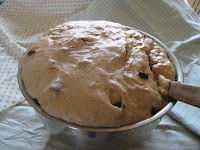Now, our tastes have all been much better developed, but this simple recipe still garners compliments. I am presenting it first in the form I used for many years and then with my modification of more recent years.
"Special" Pork Chops
"Traditional" version
canola oil
4 to 6 thin pork chops or pork steaks--about 2 pounds
juice of 1 orange OR 2 T frozen orange juice concentrate, undiluted
1 to 2 t grated orange rind (optional)
1 can cream of mushroom soup
1 t cinnamon
freshly ground pepper
1. Remove all excess fat from the chops. If boneless, cut into medallion sized pieces, about 3 inches around.
2. Brown the chops in a small amount of oil. When well-browned on both sides, spread with the mushroom soup and then sprinkle the remaining ingredients over the top.
3. Reduce heat to low, cover tightly, and simmer about 20 to 30 minutes, until the juices have turned rich brown and the meat is just tender.
Serve over mashed potatoes or rice. Enough for 4 to 6.
Updated version
canola oil
4 to 6 boneless, thin-sliced pork chops (I buy boneless pork loin and then slice it myself)--about 2 pounds
juice of 1 orange OR 2 T frozen orange juice concentrate, undiluted
1 to 2 t grated orange rind (optional)
1 t cinnamon
sauce (see below)
Sauce
2 to 3 T finely chopped onion
3 T flour
1 to 2 chicken bouillon cubes, crushed
1/3 c dry milk powder (optional)
1 to 1 1/2 c water
4 oz can sliced mushrooms or mushroom pieces--do NOT drain
freshly ground pepper
salt to taste
1. Saute the chops as in the recipe above. When browned, remove them to a platter.
2. Add the chopped onions to the drippings from the chops and saute until light golden.
3. Combine the flour, dry milk powder and crushed bouillon cubes, stirring to blend well. Add the flour mixture to the onions, and stir until completely mixed with the drippings.
4. Gradually add the water and mushrooms, including liquid, stirring constantly. Continue cooking until the mixture boils and is thickened. Season to taste.
5. Add the orange juice, orange rind, and cinnamon to the sauce.
6. Return the chops to the pan, and turn them over so that they are completely coated with the sauce. Cover tightly and simmer on low about 20 to 30 minutes, until the sauce is a rich golden brown and the meat is tender.
With either recipe, you may choose to put the meat and sauce in a tightly covered, oven-safe casserole and finish the simmering in a 325 degree oven for about 25 to 35 minutes.
Why the "Update?"
Although condensed soups have been around for years as a quick way to build a "casserole" or "hot dish" quickly, they no longer are as economical as they once were. In addition, many of these seem to have even more fillers with every "new and improved" change, so I have stopped using them almost completely.
The replacements for these soups are really not all that difficult or time-consuming to make, and they really are just glorified "white sauces." Back in the old days--you know, before electricity and the invention of the wheel, way back in the 1960s!--learning to make a good white sauce was a basic Home Ec lesson plan, so I have the good fortune to have practiced these long ago. But even those new to the technique will find it easy to do with a little practice and attention to a few very important details. In a future post, I will be spending a little more time on these sauces, hoping to give you the confidence to try them on your own.
And the flavor differences will be well worth the effort...Really!









